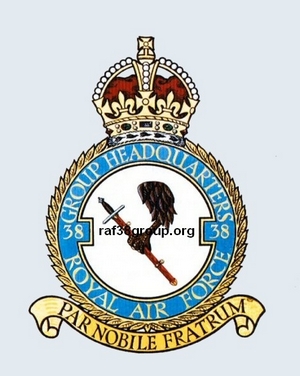
Badge: An eagle’s leg grasping a sword
Motto: ‘Par Nobile Fratrum’ – ‘A Noble Pair of Brothers’, symbolising the close association with the Army Airborne Forces
HISTORY
No.299 Squadron was formed at Stoney Cross on 4 November 1943 – The nucleus of the personnel of the Squadron were drawn from ‘C’ flight, No.297 Squadron (42 Crews, each Crew of 5 members, and ground crews of 200 men). The Squadron was equipped with Ventura glider tugs.
No.299 Squadron had been formed in No.38 Group to tow gliders and drop paratroops but, as other No.38 Group Squadrons, later other tasks came as supply-dropping missions for resistance forces in Europe (particularly in France) and sorties in support of SOE.
15 November 1943 was an important day: No.299 Squadron was transferred from 2nd TAF to Allied Expeditionary Air Force (AEAF) and Air Vice Marshall Hollingurst CB, OBE, DFC, AOC No.38 Group came to visit the Squadron and later No.297 Squadron.
Training with the Airborne forces took up most of the Squadron’s time and in January 1944, No.299 was the first No.38 Group Squadron converted (with 21 crews) to Stirling IV at 1665 HCU Woolfox Lodge.
In March 1944, No.299 Squadron moved to Keevil but the same month some crews flew to Tarrant Rushton for SOE operations (See also No.196 Squadron History).
In april 1944, SOE missions flown by very small number of aircraft continued.
In May 1944, operational missions were flown from Tarrant Rushton.
But during this time, No.299 had also worked up its role in the Normandy landings (Operation Overlord).
On 05 June 1944 at 2319 hrs, along with 23 Stirlings of No.196 Squadron, the first of the 23 Stirlings of No.299 Squadron took off to drop troops of 12th Parachute Battalion, 5th Parachute Brigade, 6th Airborne Division on DZ ‘N’ for Operation ‘Tonga’ (drop at 0057 on 06 June). Unfortunately Flight Sergeant Gilbert’s aircraft failed to return.
Warrant Officer Towell, No.299 Squadron, also took off on 05 June but from Keevil and for an SOE mission.
Later on 06 June, for Operation ‘Mallard’, 18 Stirlings took off again to tow Gliders (carrying troops and equipments of 6th Airborne Division Air Landing Brigade) to LZ ‘W’ on the West Bank of the River Orne, to reinforce the troops holding the bridges over the River Orne and the ‘Canal de Caen’. A battle was raging on DZ ‘W’ when the gliders landed and both side stopped fighting to watch the gliders land!
Unfortunately, one other aircraft was lost. Flying Officer Clark’s aircraft was seen to plunge in the sea on returning of ‘Mallard’.
Until September 1944, supply drops to allies in France continued (like Operation Rob Roy with 6 aircraft on 08 June) but also SOE and SAS operations (sometimes from Fairford).
On 17 September 1944, for Operation Market I, 25 aircraft towed gliders to capture 3 important bridges at Grave, Nijmigen and Arnhem.
Until 23 September 1944, No.299 Squadron made 87 re-supply flights to troops for Operations Market II, III, IV, V and VII. The Commanding Officer of the Squadron Wing Commander DAVIS DSO and 3 other men were killed, and 5 aircraft didn’t return from this operations.
No.299 didn’t stop special operations after ‘market’ operations.
No.299 was involved in last major airborne operation on 24 Marsh 1945 : ‘Varsity’, the Rhine crossing. It supplied 29 aircraft without loss (103 troops carried plus many vehicles).
After ‘Varsity’ special operations were now flown mainly over Scandinavia.
At the end of February 1945, No.299 Squadron began tactical bombing raids in support of the Army but on 22 February, Squadron Leader Spear DFM failed to return.
On 05 May 1945, No.299 Squadron supplied 19 aircraft to carry troops to Copenhagen, Denmark (Operation ‘Schnapps’) then in May came the carriage of others to Oslo and Stavanger, Norway (Operation ‘Doomsday’) to disarm the German occupation forces and after a period of general transport duties the squadron disbanded on 15 February 1946.

Commanding Officers
04 November 1943 Wing Commander R.W.G KITLEY
28 December 1943 Wing Commander P.B.N. DAVIS DSO
(KiA during Operation ‘MARKET III’ on 19 September 1944)
September 1944 Wing Commander P.N. JENNINGS DFC, S S(US)
(Temp O.C.)
S S(US): Silver Star – United States of America
01 November 1944 Wing Commander C.B.R. COLENSO DFC
31 December 1944 Wing Commander P.N. JENNINGS DFC, S S(US)
September 1945 Wing Commander R.N. STIDOLPH

Date / Base / Aircraft
4 November 1943 Formed at Stoney Cross – nucleus from ‘C’ flight, No.297 Squadron
November 1943 / Stoney Cross / Ventura I, Ventura II
January 1944 Ventura I is retired
January 1944 Ventura II is retired
January 1944 / Stoney Cross / Stirling IV
15 March 1944 / Keevil / Stirling IV
9 October 1944 / Wethersfield / Stirling IV
25 January 1945 / Shepherds Grove / Stirling IV
January 1945 / Shepherds Grove / Stirling IV, Stirling V
15 February 1946 Squadron Disbanded
Next page: 570 Squadron

